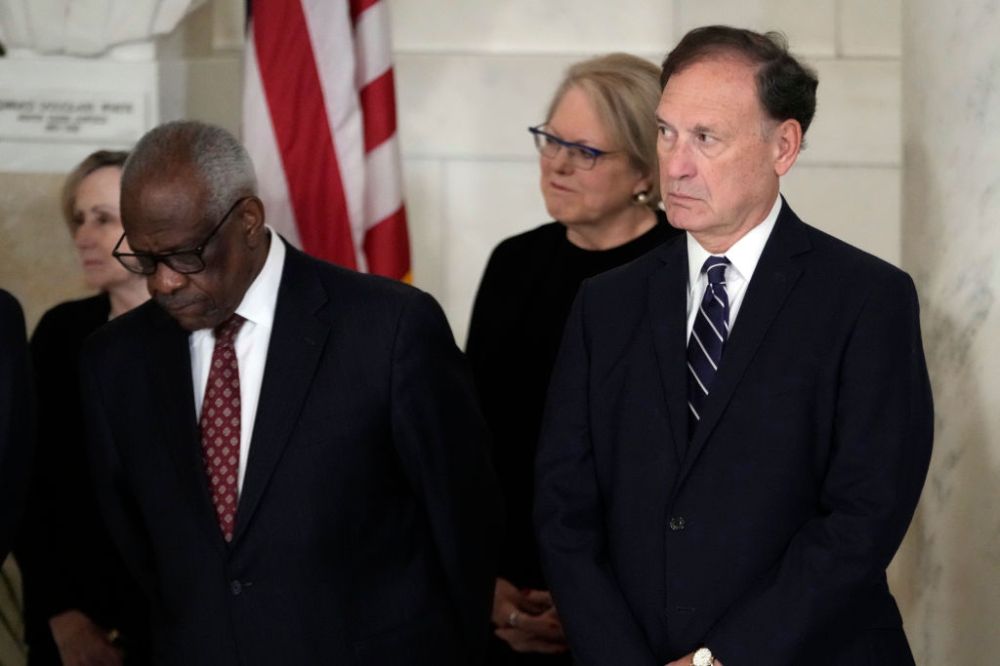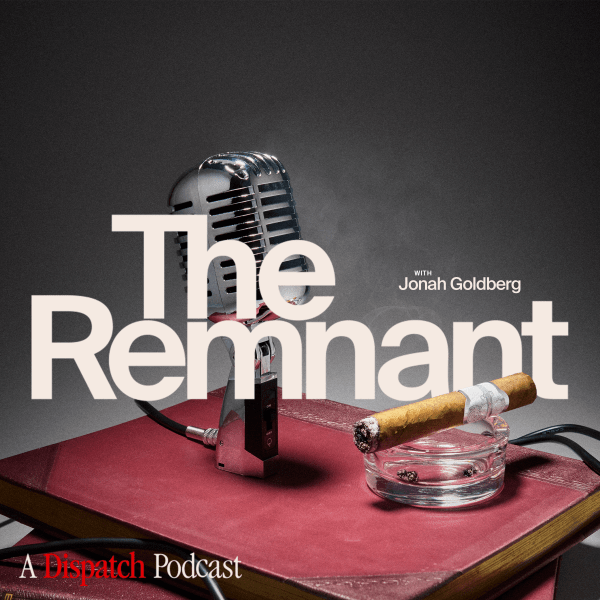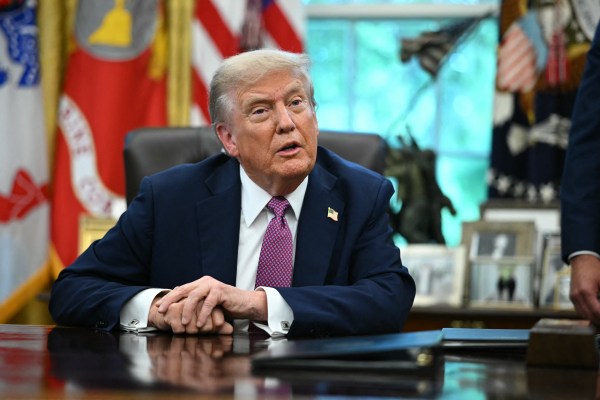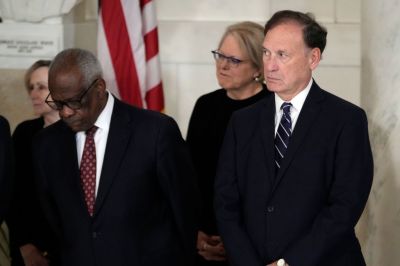The political problem of our age is not knowing whom to trust. A superb little example is the story the New York Times published on Thursday about Supreme Court Justice Samuel Alito.
The Times revealed that an upside-down American flag was flown outside the Alito home on January 17, 2021, shortly after the insurrection at the Capitol and shortly before Joe Biden’s inauguration. A contemporaneous email sent by a neighbor claimed that the flag had been like that for several days. Multiple eyewitnesses assured the paper that it happened. The Times even snagged a photo from one.
Flying the flag upside-down is a “signal of dire distress in instances of extreme danger to life or property” under the U.S. Flag Code but it’s been adopted by some as an expression of urgent political dissent. Notably, it popped up a lot among “Stop the Steal” fanatics after the 2020 election. Last night two different Dispatch colleagues reported seeing it flown commonly in Trumpy areas where they lived around January 6. There are photos of it being carried by the rioters outside the Capitol that day.
And there it was, around the same time, in front of Sam Alito’s house.
Surprisingly, the justice himself confirmed the basics of the story for the Times. The upside-down flag had been there, he admitted—but observers had mistaken its meaning. “I had no involvement whatsoever in the flying of the flag,” he insisted. “It was briefly placed by Mrs. Alito in response to a neighbor’s use of objectionable and personally insulting language on yard signs.”
Whom do you trust here? Should you trust anyone?
Do you trust Alito’s neighbors? Lord knows what sort of bitter grudges might be distorting their accounts of the context surrounding the flying of that flag. Alito went on to write the majority opinion when the court overturned Roe v. Wade in 2022, of course, a fact of which his pro-choice neighbors are no doubt keenly aware. If they interpreted the upside-down flag as a symbol of solidarity with the January 6 insurrection, it’s strange that they didn’t think to mention it to reporters at the time. And if, as the Times claims, they kept quiet back then due to fear of “reprisals,” why aren’t they similarly fearful now?
Do you trust the Times? It’s verrrry curious that reporting on this three-year-old incident has conveniently emerged just as the Supreme Court is considering former President Donald Trump’s claims of “absolute immunity” for his actions in trying to overturn the election. Our liberal media might be trying to preemptively discredit the court’s forthcoming decision, expecting that it won’t reject Trump’s arguments as emphatically as it might. Perhaps the Times is even hoping to pressure Alito into recusing himself belatedly.
Do you trust the partisan spin on either side? For the left, still bristling at Alito over the end of Roe, this story will slot easily into their case that the court’s conservative majority is teeming with activist Republican hacks. For the right, grateful to Alito for a career that’s produced numerous conservative wins, the story will be a hysterical overreaction to an ambiguous act that’s obviously been contrived to discredit the justice and his jurisprudence.
Needless to say, had the same set of facts involved a liberal judge and a slightly different flag, the partisan takes would instantly reverse.
How about Sam Alito? Do you trust him?
I don’t. Although that’s not entirely his fault.
It’s partly his fault. His explanation for how the flag ended up flying in front of his home makes little sense.
He elaborated on what he told the Times in an interview with Fox News’ Shannon Bream on Friday. According to Alito, a neighbor had posted a sign that read “F— Trump” within 50 feet of a school bus stop. When Martha-Ann Alito complained, the neighbor put up another sign accusing her of complicity in the January 6 attack somehow. One day the Alitos encountered someone who lived in the same home and he ended up cursing them out during the argument that ensued, even calling Mrs. Alito “the C-word,” her husband alleged. That’s when she decided to fly the upside-down flag.
I’ve never heard of that symbol being used as an expression of general anger. It’d be like burning a flag in your front yard and, when asked what you're protesting, replying, “Nothing. I just hate my neighbor and want to annoy him.”
It’s a weirdly political way to express personal antipathy.
The most charitable interpretation of why Mrs. Alito did what she did is that she had no idea that the upside-down flag had become a symbol of “Stop the Steal” among right-wingers at the time. She was antagonized by the “F— Trump” sign she saw but probably felt that she couldn’t respond in kind with a “F— Biden” sign lest that make trouble politically for her husband. So she chose the more debatable message of the “distress flag” instead.
It’s possible. But it would be quite the coinkydink if one of the most powerful conservative couples in America resorted to this symbol purely by chance at the very moment it was being popularized by insurrection sympathizers. What a stroke of bad luck for the Alitos.
Another charitable interpretation is that Mrs. Alito was spitefully mocking the man who accused her of supporting the insurrection. Imagine Sonia Sotomayor responding to an angry neighbor who had called her a “communist” by running the upside-down flag up her house’s flagpole. The same mischievous logic gripped Mrs. Alito, perhaps: You think I’m anti-American, you jerk? Fine, here’s the insurrection flag for you.
People do foolish things in the heat of the moment when they’re angry.
But it wasn’t just a “moment,” was it? According to the Times’ source, the flag stayed up for days. And unless you believe the Alitos were blissfully unaware of its meaning among the populist right circa January 2021, it’s astoundingly terrible judgment on their part to have embraced the symbol even for the limited purpose of mockery. There would be no “good” explanation for a Supreme Court justice to burn a flag in his front yard, even if his intentions weren’t anti-American. Same here.
To return to the Sotomayor hypothetical, no one on the American right would believe that a left-wing justice had flown a “distress flag” purely to spite a neighbor. At best, Republicans would treat it as a case of “kidding on the square”: The flag might have been displayed as a goof on the hyperbole of a neighbor, but to display something as offensive as that over your home—even in jest—you’d need to be more comfortable with giving offense than you should be. The same goes for the Alitos and their own “distress flag.”
And so we arrive at Occam’s razor. The simplest explanation for all this is that Mrs. Alito, or both Alitos, sincerely sympathized with Trump’s claims about an unfair election. They refrained from expressing those sympathies so as not to call the justice’s impartiality into question, but their anger at being harassed by their neighbors lowered their inhibitions. They flew the flag upside-down because they supported the political cause that it represented.
Alito’s account to Shannon Bream of what happened doesn’t really pretend otherwise. The point of his version of events is less that his and his wife’s intentions were innocent than that their left-wing neighbors are terrible, vulgar people. “Don’t focus on the bad thing we did,” he seems to be telling conservatives, “focus on the bad things the libs did to us.” That type of damage control is very Trumpy in spirit.
So, yes, it’s partly his fault that I don’t trust him in this matter. But only partly.
Not long ago, it would have been ridiculous to accuse the spouse of a Supreme Court justice of agitating for a coup.
But it’s not so ridiculous anymore, is it?
The shadow hanging over the Alitos is, of course, that of Clarence Thomas’ wife, Virginia. Flying an upside-down flag over one’s home could plausibly be an innocuous gesture mistaken by bystanders as something sinister. What Ginny Thomas did following the 2020 election can’t be mistaken for anything but earnest insurrectionism.
That’s the lens through which the Times’ story is being viewed, perhaps unfairly but unavoidably. If one Supreme Court justice is in bed (literally!) with a coup-supporter, why wouldn’t two be? If Virginia Thomas cares so little for her husband’s and the court’s reputation that she would undertake political activity destined to damage both once it was found out, why wouldn’t Martha-Ann Alito?
For a radical like Mrs. Thomas, diminished respect for the court might be a necessary evil of her political project. However ambivalent she might be about seeing her spouse and his place of business viewed suspiciously due to her activities, shaking the public’s faith in institutions is what populism is all about. The less both parties trust the judiciary, the easier it’ll be for her party to justify ignoring adverse court rulings when necessary going forward.
It’s always been hard to believe that she did what she did after the 2020 election without the knowledge, and at least tacit support, of her husband. It’s likewise hard to believe that Sam Alito didn’t notice the upside-down flag flying outside his home for days or, if he did, that he didn’t understand what it might represent. Irrespective of the political context, one would think a Supreme Court justice would move instantly to distance himself from a strange, disrespectful public display of the stars and stripes. But he didn’t, it appears. Why not?
Maybe he and his wife deserve the benefit of the doubt. Thanks to the Thomases, they can’t have it.
But not just the Thomases. The reason the Times report on the Alitos hit anti-Trumpers so hard is because it distilled the brazenness of MAGA fanaticism since the insurrection. We’ve all come to accept, however uneasily, that true-believing populist radicalism long ago migrated up from the grassroots to the tippy top of the conservative establishment, even infecting the home of Justice Clarence Thomas. Yet the spectacle of a “Stop the Steal” symbol flying proudly in front the Alito home after January 6 raises the possibility that there’s no longer any shame in associating with it, even among the right’s leading intellectual lights. Including those who are duty-bound to place fidelity to the constitutional order above Donald Trump’s desires.
It’s a microcosm of how conservatives’ accommodation of post-liberalism is happening in plain sight.
The results of this year’s primary made that clear, but it’s worth remembering how recent it was that conservatives would scoff whenever anxious nerds like me wrung our hands about authoritarianism. Days after the 2020 election, figures like Mick Mulvaney were still insisting that Trump would concede gracefully. Eminent pundits like Ross Douthat declared in October of that year that there would be no Trump coup. In mid-November, in a story about Republicans starting to line up behind the president’s “rigged election” nonsense, the Washington Post printed this infamous quote from a senior Republican official: “What is the downside for humoring him for this little bit of time? No one seriously thinks the results will change.”
You don’t hear much scoffing anymore.
But why would you? Trump’s illiberal plan for a second term is happening in plain sight. Time magazine summarized the takeaways from its recent interview with him this way:
He would, at his personal discretion, withhold funds appropriated by Congress, according to top advisers. He would be willing to fire a U.S. Attorney who doesn’t carry out his order to prosecute someone, breaking with a tradition of independent law enforcement that dates from America’s founding. He is weighing pardons for every one of his supporters accused of attacking the U.S. Capitol on Jan. 6, 2021, more than 800 of whom have pleaded guilty or been convicted by a jury. He might not come to the aid of an attacked ally in Europe or Asia if he felt that country wasn’t paying enough for its own defense. He would gut the U.S. civil service, deploy the National Guard to American cities as he sees fit, close the White House pandemic-preparedness office, and staff his Administration with acolytes who back his false assertion that the 2020 election was stolen.
On Friday, no less than nine sources who are helping to prepare Trump’s agenda for a second term confessed to Reuters that he aims to turn the Department of Justice “into an attack dog for conservative causes.” The plan has two parts, they eagerly explained. “First: Flood the Justice Department with stalwart conservatives unlikely to say ‘no’ to controversial orders from the White House. Second: Restructure the department so key decisions are concentrated in the hands of administration loyalists rather than career bureaucrats.”
Trump has been babbling about “retribution” on the campaign trail for more than a year. He salutes at rallies when a musical tribute to the insurrectionists is played. He makes no pretense that he’ll allow the criminal cases against him to continue if he’s reelected. Lately, he’s made his demagoguery of the justice system that’s trying to hold him accountable a true Republican team effort by having “respectable” members of his party show up at the courthouse and join in the fun.
This is all happening in plain sight.
It’s why, I suspect, Democrats have had such a hard time believing that Trump really is leading in the polls. It would be one thing if he were pretending to be a subdued, sober politician who’d seen the error of his ways and vowed to uphold the rule of law in a second term, but he isn’t. He’s flying his freak flag more brazenly than ever. The country is prepared to reelect him anyway. If it does, he’ll draw the appropriate lessons.
Joe Biden’s theory of the election at the moment is that Americans haven’t fully awakened yet to the likelihood of a second Trump presidency or what it would entail. Once they do, the polls will move. But that theory loses credibility day by day, as Trump patiently and relentlessly goes about making his intentions clear.
Maybe the electorate is oblivious, like Justice Alito was oblivious to an insurrectionist symbol flying in his front yard. Or maybe each simply warmed up to the new reality of what it means to be right-wing in America.
Our friend David French reminded his readers today of one of Jonah Goldberg’s most famous columns, the Invasion of the Body Snatchers piece from March 2016. It was written just as Trump was locking up the Republican presidential nomination for the first time. The influence of ascendant MAGA populism on conservatives whom he’d known for years wasn’t merely profound, Jonah wrote. It was eerie.
He described the change his way: “Someone you know or love goes to sleep one night and appears the next day to be the exact same person you always knew … Except they’re different, somehow. They talk funny. They don’t care about the same things they used to.”
That was eight years ago. By now, every person reading this has had extensive personal experience with the phenomenon he observed. It’s happened again and again, in plain sight.
That experience is inescapable context for the reaction to the Times’ story. Maybe the Alitos are getting a bad rap about the flag. Maybe the justice is prepared to thwart Trump’s unconstitutional ambitions in a second term.
Or maybe another body is on its way to being snatched. Why should the Supreme Court be immune from to an ideological virus that’s convinced right-wingers that vindicating America’s constitutional vision requires empowering Donald Trump?
Until the body-snatcher era ends, no one who shows evidence of having been snatched gets the benefit of the doubt. Not at the bottom of the conservative movement and not at the top either.







Please note that we at The Dispatch hold ourselves, our work, and our commenters to a higher standard than other places on the internet. We welcome comments that foster genuine debate or discussion—including comments critical of us or our work—but responses that include ad hominem attacks on fellow Dispatch members or are intended to stoke fear and anger may be moderated.
With your membership, you only have the ability to comment on The Morning Dispatch articles. Consider upgrading to join the conversation everywhere.